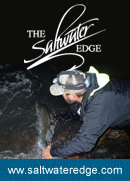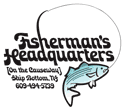http://www.thefisherman.com/index.cfm?
To say that the bass fishing has been a disappointment so far this year would be an understatement! For the past 7 years I have been telling Mike Armstrong, Assistant Director of the Ma. DMF that there are less and less bass each year and I kept asking “why do you keep increasing commercial quotas”? I was continually subjected to things like : “you are imagining things”, “you don’t know what you are talking about”, “everyone is catching plenty of fish”,etc………
My boat was catching plenty of fish as well but that was not the point I was trying to make and they did not want to know. “Fish management” is all about MONEY and on the state level there is a lot of pressure on the “managers” to “bring money into the state. Stripers are a bit of a cash cow for Massachusetts because most of the commercial landings go right to New York City and we (state residents) get money for that. Money is then spent (hopefully) in our states retail stores and our local economy is “stimulated”. Other commercial bass sale states see things pretty much the same way so the money comes 1st and the resource comes “somewhere after that”.
For many years that same mentality kept poachers in business as enforcement was not being pushed to take care of the issue. After all, it was just some harmless commerce. By my “rough estimates” and from what I know about poaching (I myself was a poacher for a few years in the late 80’s. I have long since been reformed), the black market “take” of striped bass is at least equal to the legal harvest quota. I believe that the management people know this but intentionally ignore it when they are pushing catch statistics to justify increasing commercial quotas which is what they have done steadily for the past two decades.
Much of the “reasoning” behind the limits that they set were from the “rational” that we are only going up to “traditional harvest levels”. Why didn’t any of those Menza candidates ask: “If the harvest levels of before collapsed the stock before, won’t that happen again”? DUH! “The beginning of the end” before the last stock collapse of the mid eighties was when the draggers out of North Carolina and Virginia started “working on” the bodies of fish that wintered off their coasts in January and February before they went into the estuaries to spawn in late winter. In 1981, my friend and bass fishing partner “Artie Johnson” was showing me the market reports from Fulton Fish Market and how the massive shipments of bass from Va. and NC sent the price of bass down to 10 cents a pound during the prior winters. Back in 2006 those draggers started “ramping up” once again and a few years later, here we are again. Draggers and stripers do not mix well. When they do, it is always bad for the stripers. In fact for awhile a few years back the standard practice for draggers in NC, where they were allowed to take/sell 50 bass a day was to tow through a school of bass and kill 1000 fish and then throw the 975 smallest ones overboard (dead). Then tow again for another 1000 fish to retain the remaining 25 of their daily quota! There were acres of dead bass floating all over the place down there and the practice made such a sensation on the internet that the regulations were quickly changed to curb the practice. Of course the draggers said they were doing nothing illegal and they are right. “Anything moral ?”, is another question.
Do we “need” a total moratorium now to fix things? No! However, a three to four year shutdown of the commercial harvest is surely in order as well as a 50% cut to the recreational take (one fish over 28 or 32 inches would be well served). Then, if/when commercial harvest is brought back, nets of any kind should never be allowed. Further, the “harvest” should never approach any more than 1/2 of what today’s quotas are and any form of poaching, if convicted, should bar that offender from all commercial fishing for a year. A second conviction should bar them for life. As it is today I have heard poachers and black market dealers refer to the slap on the wrist they get as “the cost of doing business”!
Lastly, we have all heard the argument that charter boats are amongst the biggest offenders and I’m afraid that reputation is somewhat deserved. However the one fish limit should address that nicely with perhaps a one “trophy fish” per trip stipulation thrown in there to appease that user group and their customer base. It’s not a perfect world and there are no easy answers but some things are best kept simple and we need to learn from our past mistakes. Traditional harvest levels on a supposedly rebuilt stock do not work. If nothing else, lets learn from that.
Captain Jason Colby
Little Sister Charters
fishinglsister@aol.com
617-755-3740
www.littlesister1.com
Thursday, July 31, 2014
MARYLAND SEEKS TO SLOW STRIPED BASS RECOVERY
Most of our striped bass are spawned in Chesapeake Bay, and most of those come from the waters of Maryland. For that reason, Maryland’s striped bass young-of-the-year index has generally been the best future predictor of the future health of the stock.
Thus, folks who care about the striper’s future have been rightly concerned by the fact that the index has been coming in below average for most of the years in the past decade, with the 2012 index the lowest in more than fifty years—even lower than anything recorded during the depths of the last stock collapse.
The one bit of good news came in 2011, when a dominant year class was produced.
You would think that the folks who manage bass down in Maryland would be doing whatever they can to help those 2011s live long enough to recruit into the spawning stock, something that should happen in 2017 or so.
But if you thought that, you would have been wrong.
Maryland has a long history of killing immature bass (back before the collapse, a legal “pan rock” was just 12 inches long), and it doesn’t look like they’re planning to reform any time soon.
Right now, they’ve got the 2011s fixed dead in their sights.
It started last fall when, despite the steady decline if the spawning stock biomass, the state declared its intention to increase the harvest by 14% in 2014. I suppose that went over well with the folks who make their money off the heads of dead fish, but folks capable of thinking about the long term—which, in this case, is anything past the current season—figured out that beating up on the only solid year class in the last decade was probably a dumb idea.
Coastal Conservation Association Maryland, which seems to represent the most rational and responsible anglers in the state, made a really solid effort to prevent such foolishness from going forward but, in the end, the chance of plucking more dollars from the heads of dead bass proved far too attractive for the state to change course.
So this year, the Maryland folks are killing more bass, even though a peer-reviewed stock assessment, that was presented to the Atlantic States Marine Fisheries Commission last October, and updated in December, noted that
“If the current fully-recruited [fishing mortality rate] (0.200) is maintained during 2013-2017, the probability of being below the [spawning stock biomass] reference point increases to 0.86 by 2015…If the current fully-recruited [fishing mortality rate] increases to Fthreshold(0.219), and is maintained during 2013-2017, the probability of being below the [spawning stock biomass] reference point reaches 0.93 by 2015 and declines thereafter…
“…there is a probability of 0.46 that the 2012 female [spawning stock biomass] is below or equal to the [spawning stock biomass] threshold, and a probability of 0.31 that the 2012 fully-recruited fishing mortality is above or equal to the fishing mortality threshold…”
The stock assessment also made it clear that, although the stock was not yet overfished and that overfishing did not occur in the past couple of years, the target fishing mortality levels had been exceeded, and the spawning stock biomass had been below target levels since 2006.
Amendment 6 to ASMFC’s striped bass management plansays that
“If the Management Board determines that the fishing mortality target is exceeded in two consecutive years and the female spawning stock biomass falls below the target in either of those years, the Management Board must adjust the striped bass management program to reduce the fishing mortality to a rate that is at or below the target within one year.“
That seems pretty clear, but not if you’re Thomas O’Connell, the marine fisheries director for the State of Maryland. He took a look at Amendment 6, and its mandate to reduce fishing mortality, but wasn’t too impressed.
Instead of making meaningful changes to the management program in order to reduce fishing mortality to the target level, O’Connell decided that he’d rather make changes to Amendment 6, and allow harvest reductions to be phased in over three full years, instead the one year currently required.
As too often happens at ASMFC, it was a matter of elevating short-term economic gains over the need to conserve and rebuild the stock. At the May Striped Bass Management Board meeting, O’Connell said
“I think it really comes down to a cost-benefit analysis and trying to weigh the impacts versus the likely benefits of our action today…
“I think, as I mentioned earlier, a 32 to 36 percent reduction is going to have large socio-economic impacts as well as potential ecological impacts. I think we don’t have a stock situation that is in dire need of protection…”
Not everyone on the Management Board shared that view. Paul Deodati, the state fisheries director from Massachusetts, eloquently opposed O’Connell’s approach, correctly noting that
“We’re actually working off the tenets of Amendment 6, which are pretty clear about what this board is supposed to do. We’re not supposed to wait until new fall down well below the levels that [Thomas O’Connell is] suggesting. We’re supposed to take an action now.
“It is always difficult when we have to make a cut, especially when our fisheries aren’t completely falling apart; but with striped bass we took a very deliberate approach to how we were going to react to and address changes in stock condition. This is the change that we identified many years ago as a point in time when we’ll take a serious action to reduce fishing mortality. We’ve reached that. In fact, in my belief we have gone well beyond the time that we allowed ourselves to take this action.
“I think that any further delays is going to hurt the credibility of the commission. It is going to completely tarnish the integrity of the Striped Bass Management Plan, which I think we’ve worked really hard to maintain as a top-notch managed program. I don’t think that’s our intent, but I’m afraid that would be the result of delaying action on this…“
Pat Augustine, proxy for New York’s legislative appointee, also raised the issue of ASMFC’s credibility, pointing out that
“I think at the end of the day if we just decide we’re not going to follow through on what our commitment was last year to be well on our way to recovery and implementation January of 2015 and come up with anything that is going to dilute the direction we’re going, I think we will totally lose the credibility of the public…
There is a lot of emotion out there; and to do anything other than what we committed to do, we’re going to have mud all over our face and we’re going to embarrass ourselves…“
However, Tom Fote, governor’s appointee from New Jersey and long-time opponent of ever reducing the recreational harvest of anything, regardless of the health of the stock, was quick to jump on the O’Connell bandwagon, trying to discredit Augustine with a somewhat unintelligible argument that
“The credibility is that we’re basically trying to accommodate fishermen. New York has always wanted one fish. When we opened the fishery when there is plenty of fish, their surf fishermen wanted one fish. That is not the reality in New York.
“That is the reality of other states, and this is a compact of all the states that we try to accommodate our fishermen whatever they need…
“I have no problem and our credibility always stands as it is…”
Although, in the end, the facts spoke for themselves, and Deodati was clearly correct. When ASMFC adopted Amendment 6, it made a covenant with the public to take management action when a trigger was tripped. Should the Striped Bass Management Board ultimately approve a three-year phase-in of the reduction, it will have violated the public trust, and demonstrated that its word is not to be trusted.
Hopefully, that will not happen, but…
There’s no doubt that Maryland is going to work hard to make that happen, and in the end, it’s easy to understand why.
The 2011 year class won’t recruit into the coastal fishery until 2017. Until then—perhaps not coincidentally—Maryland and the other Chesapeake fisheries will have them to themselves. The females will migrate out of the bay for the summer, but most of the males will stick around, and the Maryland fishermen—commercial and recreational—and the Maryland charter boats will be able to pound on them pretty hard while they’re around.
Given that the 2011s are the first good year class since 2003, that 2012 was the worst ever recorded and that we don’t know when the next good spawn will be (although there’s reason to hope that 2013 might be solid), it’s hard to blame Maryland for trying to take what they can while the taking’s good.
Except…even their own anglers are cautious. CCA Maryland adopted its “My Limit is One” campaign to try to protect some fish and mitigate the damage that the 14% harvest increase will do.
So why does Maryland want to kill so many striped bass?
As O’Connell said, for “socio-economic” reasons.
Which is the nice way of saying that it’s all about the almighty buck, and someone trying to squeeze a little more blood from the stone before casting it aside.
We always have to remember that responsible anglers such as the folks at CCA Maryland aren’t the only people fishing for bass.
Maryland’s commercial sector killed 2,524,181 pounds of stripers in 2012 (compared to the 1,445,187 pounds landed by its anglers), and it has a big charter fleet that puts dead bass high on its list of priorities, killing 46% of the entire recreational harvest. O’Connell is trying to put a little more money in their pockets today, rather than trying to restore the stock—and so putting more money in their pockets tomorrow.
Even Maryland’s United States senators got into the act. A letter addressed to Robert Beal, ASMFC’s Executive Director, co-signed by Senators Barbara A. Mikulski and Benjamin L. Cardin says that the proposed reduction in striped bass harvest
“will adversely impact Maryland’s striped bass fisheries—and could affect entire Bay communities and other fishery industries as a whole—without the benefit of achieving the Commission’s desired level of protection to the spawning stock…
“The Commission is considering action due to concerns over a fishing mortality rate that exceeds the target level, and the dacade long decline in the female spawning stock. Both of these conditions warrant some conservation action, but that action should not be so extreme as to cause undue economic hardship to coastal communities…
“We ask for the Commission’s continued support for inclusion of a multi-year approach to reducing fishing mortality to the target level…”
In other words, the good senators know that there’s a problem with the striped bass stock, and know that something needs to be done, but doesn’t want ASMFC to do anything that might—according to the best available science—be truly effective, because that might affect the short-term health of some constituents’ bank accounts.
What is worthy of note—and particularly heartening to those who support doing the right thing for the striper—is that the senators’ letter was the only letter received by ASMFC that supported the three-year phase in of harvest reductions.
All 36 of the letters included in the original meeting materials (which include a petition signed by 1,428 people), and the remaining 51 letters included in the supplemental materials, supported imposing meaningful harvest restrictions. None supported a three-year phase in of harvest reductions, and the vast majority specifically opposed such action.
The other comments received from Maryland residents included 14 letters from individuals, who asked the Management Board to “cut the fishery…as much as you can legally” and one from a Solomons-based charter boat captain, who said that
“The people from Md DNR have done nothing about the decline of the striped bass. I fish about 100 trips a year that the decline is Very Clear [sic] a limited number of rock fish in a small area that will be wiped out sooner than later.”
It doesn’t seem likely that the captain would appreciate the position taken by O’Connell, his state fishery director, nor with that taken by Senators Mikulski and Cardin…
All 17 letters received from anglers in Virginia, which shares Chesapeake Bay—and any special Chesapeake Bay regulations—with Maryland call for taking action in one year, not three.
Maryland’s staunchest allies on the Management Board, Tom Fote of New Jersey and Rick Bellavance of Rhode Island (who said “..from the folks that I speak to in our neck of the woods, we don’t see a problem”), don’t seem to have much constituent support. There were no comment letters from New Jersey at all, while the only comment letter from Rhode Island stated that
“THERE ARE FEWERE AND LESS [sic] LARGE BASS AND IT’S GETTING WORSE EVERY YEAR. Traditional areas of past striped bass abundance are shells of what they used to be…Even the commercial fishermen have to travel farther and farther to target dwindling stocks of striped bass“
and supports
“…drastic action…Complete moratorium on commercial and recreational harvesting of striped bass until stocks are at 2006 levels or at a minimum of one fish at 36 inches…“
So it looks as if Maryland officials—both its fisheries director and its U.S. senators—and their allies from other states have taken a position that is not supported by the public at large, by Amendment 6 to the management plan nor by the stock assessment.
I suppose that only the folks who profit from dead striped bass stand behind them.
Yet they continue to oppose needed conservation measures.
Which just shows, once again, that so long as there is money to be made, there will always be someone trying to do the wrong thing at ASMFC.












Deja vu – even during the last crash there were some of the same user groups (charters/pinhook/gill net/trap) claiming there was nothing wrong with the fishery and the rest of us were full of …. Fortunately enough political pressure was placed upon managers to make changes but the trump card was the PCB scare which shut down the markets indirectly – although many of the PCB bass were sent to California through consignment by Fulton.
↓As in the past special interest groups are considered far more important than the Striped Bass Fishery(resource). Until the general public is prodded..as was the case in the Gulf Coast States(GCCA)..to take back OUR resource this horrible game (ASMFC) will continue. Starting with implementation of ‘gamefish status’ and then we rational fisherpeople can dictate the changes needed to ERR on the side of the Striped Bass Resource.
↓“Much of the “reasoning” behind the limits that they set were from the “rational” that we are only going up to “traditional harvest levels”. Why didn’t any of those Menza candidates ask: “If the harvest levels of before collapsed the stock before, won’t that happen again”? DUH! ”
This is what I have been saying to ASMFC since 2008. ASMFC has little by little lost my trust.
Thanks for SJ crew for your continue support to make things public.
↓Any governing or advisory body that panders to special interests will never have my trust. One little component of the recreational take that rarely gets mention is the many ( MANY ) who take more than 2 and take any size fish. My guess is that playing dumb is part of it but I ask myself if these guys/gals are on the websites where the troubles are discussed and even know there is a problem or that there are significant fines. Education and enforcement will always be valuable tools. I believe the governing bodies come up short on both but the education is an inexpensive fix.
↓Hail the voice of common sense and reason!!
↓I would love to see such common sense applied to the EU Fisheries people. But for some reason, the ability to do the right thing is vehemently opposed by that route of all evil, MONEY!
Sure, we all need to live and that takes money, but the world has changed and grown in population so much, that common sense is going to have to come into play soon. Otherwise we will have a world of politicians saying “Oh, if we had only done this or that, then our kids would still be able to go fishing or even eat real fish”.
the “bought” numbnuts on ASMFC couldn’t manage a fruit stand 🙁
↓Mr. Zambratta hit the nail on the head. It was the PCB’s that saved the bass stocks in the 80’s not anything else.
vito
↓We need smart fish management.
My $0.02.
↓I had no problem with the first moratorium and I don’t have a problem with another one.
↓The Comm harvest has to end now, why is it still allowed at all is beyond me. I want to see those Comm guys in the unemployment line yesterday.
↓We need some scientist to determine that MICOBACTERIOSIS, whether visibly detectable or not, is a danger to humans that consume infected fish. All of our problems will be solved……………………………………..And, along the way, the commercials and the party & charter boat crowd, (who have so effectively fought all of our conservation attempts), will find out that they can, and will, survive without the Striped Bass………..But I guess that if things continue the way they are going, they will find that out anyway.
↓Great write up I never knew there was this big of a problem. Keep up the great work and whistle blowing. Someone has to and you did a great job with the information.
↓